Wellness Program Incentives: The Complete Guide for 2024

Wellness program incentives help employees adopt and maintain healthy behaviors for the rest of their lives. Chronic diseases, elevated health risks, and many employee-related expenses are driven by unhealthy behaviors.
Ask yourself these questions:
- Why do I exercise regularly?
- Why do I eat a healthy diet?
- Why do I strive to have a healthy lifestyle?
People who maintain healthy behaviors are not motivated to do so by a gift card, or a discount on their health insurance, or a T-shirt.
Those who adopt healthy behaviors for the long haul are most likely motivated by the benefits they get from being healthy. When people internalize the benefits of a healthy lifestyle, they are more likely to keep those habits for the rest of their lives.
But this does not mean that incentives should not be used in a well-being program. The art of applying an incentive involves understanding when they should be applied and how to help people transition from an external incentive to enjoying the internal benefits of healthy behavior.
Consider this perspective. Perhaps you have heard of the transtheoretical model of behavior change. This model is often called the stages of change. It includes different psychological stages through which people progress as they learn to adopt and maintain healthy behaviors.
These stages are pretty easy to understand. They include pre-contemplation, contemplation, preparation, action, and maintenance.

The stages of change model helps us understand exactly how to apply different incentives in a wellness program. Those who exercise regularly are maintainers. They maintain daily exercise habits because they like how exercise feels.
Regular exercisers are more likely to maintain a healthy weight, sleep better, better handle stress, participate in competitive sports, or to get outside more often.
Those who exercise regularly don’t depend upon extrinsic (external) rewards or incentives to motivate them. The motivation comes from the inside. These intrinsic (internal) rewards provide motivation to continue the behavior.
Anyone who maintains a healthy behavior long-term—such as avoiding tobacco, eating healthy, getting high quality sleep, or exercising regularly—does so because they recognize the benefits that come with these behaviors.
And it is these benefits that provide the motivation to keep maintainers in the maintenance stage.

The stages of change model also includes the action stage. In this stage, people are more likely to try a new behavior. They might engage in a healthy lifestyle for the very first time.
Most people who are in the action stage respond well to extrinsic or external rewards. Here is a side-by-side comparison of the differences between internal or intrinsic rewards and external or extrinsic incentives.
| Intrinsic Rewards | Extrinsic Rewards |
|---|---|
| Provide deep personal satisfaction | Come from outside (gifts, cash, tangible rewards) |
| Are learned or discovered | Can create interest in something |
| Are driven from within | Provide positive, immediate feedback |
| Often change over time | May not lead to intrinsic motivation |
| Found in all long-term habits | Don’t always lead to long-term habits |
| Can be called benefits |
Those who are just starting a new behavior probably lack the intrinsic motivation they need to maintain the behavior because it does not yet exist. This is why the beginning of a new behavior is exactly the right time and place for well-being incentives.
All the water bottles, squeeze balls, gift cards, T-shirts, and other external rewards won’t have much of an effect on people who are already physically active.
But they will have an impact on those who are in the action stage, or those who are just beginning to experiment with a new lifestyle. External incentives can be very effective at nudging people down the road towards a healthy lifestyle.
In this respect, wellness incentives are simply a tool to encourage people to adopt healthy behaviors long enough for them to feel the benefits after which the incentive will no longer be needed.
So the challenge is to use external rewards to get people started until they recognize and enjoy the intrinsic rewards that accompany a healthy lifestyle. When an employee starts to enjoy the intrinsic benefits of their health behaviors, they are much more likely to adopt those behaviors for life.
Remember, incentives are not required to help people maintain healthy behaviors but incentives do help people in the action stage of behavior change to nudge them on their way.
Recent surveys reveal the most common extrinsic rewards used in U.S. well-being programs:
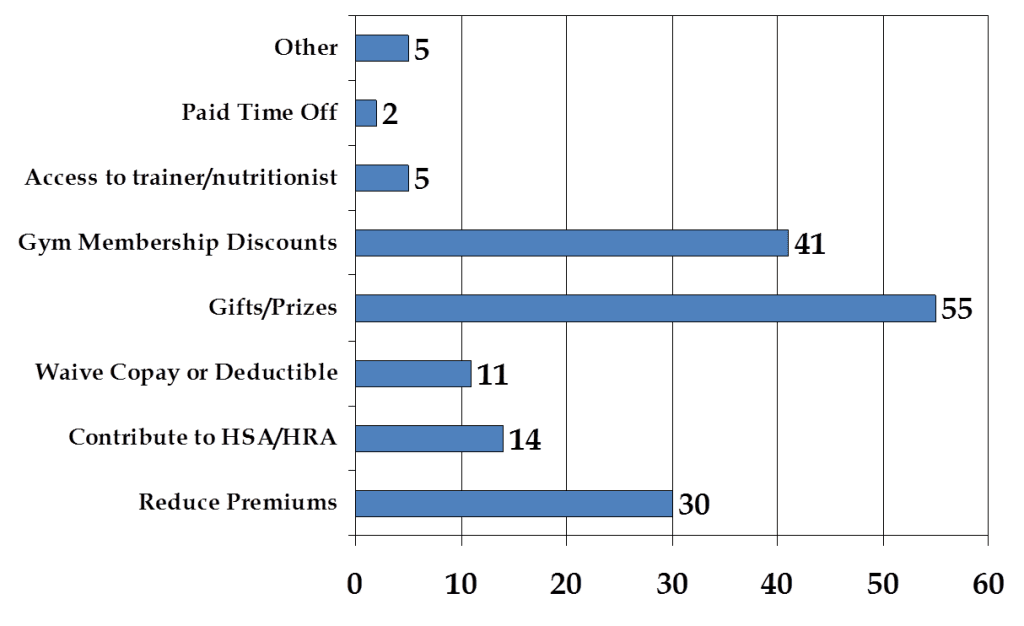
Reducing Corporate Health Care Costs 2013; Deloitte Consulting LLP, January 2014
WellSteps uses incentives with all of our wellness customers. We use incentives because they make a big difference in helping people get started and we understand that.
We also understand that they are not a long-term solution to behavioral maintenance. Here is an example of what most WellSteps clients do in their wellness incentive programs.
Since the goal of the well-being program is to help employees adopt and maintain healthy behaviors, we provide small gift cards that are randomly awarded to those employees who successfully complete different aspects of a wellness program.
For example, completing a personal health assessment, biometric screening, behavior change campaign or challenge will qualify an employee for a drawing. We don’t give these small incentives to every single employee, but they do get a chance to win.
We have found that even greater participation happens if the employers will establish a benefits-based incentive plan.
Benefits Based Incentives Explained
Benefits-based well-being incentive programs typically include the incentive of a discount on insurance premiums, paid time off, a contribution to an HSA or HRA, or a lower co-pay or deductible.
Benefits-based incentives are more expensive than randomly awarded gifts but they tend to have more impact on employee engagement.

Some WellSteps clients offer a $50/month discount off the cost of an insurance premium, or $600 per year per qualifying employee. Some companies spend more and some spend less than this.
For many years, WellSteps and other wellness consultants have studied the impact of various wellness program elements including incentives on program participation. From this work, we have categorized wellness program engagement strategies into four categories:
- Minimal Communication: with minimal communication, employee well-being programs make program announcements via email, newsletters, and posters. Typically with this type of marketing results in about 19% of employees who participate.
- Extrinsic rewards or incentives: employees are offered rewards when they participate in various wellness activities. The use of incentives can induce another 27% of employees to engage.
- Wellness committee involvement, targeted program marketing: any time employees are involved in the worksite well-being committee, there is a tendency for wellness programs to have better participation. Having employee representation on a wellness committee gives employees a sense of program ownership. Companies with a wellness committee are more committed and motivated to see that the program is successful. When committee efforts are combined with carefully written and targeted marketing materials that use text messaging, creative graphics, video, company newsletters, and special invitations, engagement goes up another 19%.
- Benefits-based incentives strategy: lastly, when companies use a benefits-based incentive strategy the motivation to participate dramatically increases. Companies with a benefits-based incentive program typically have 30% more participation.
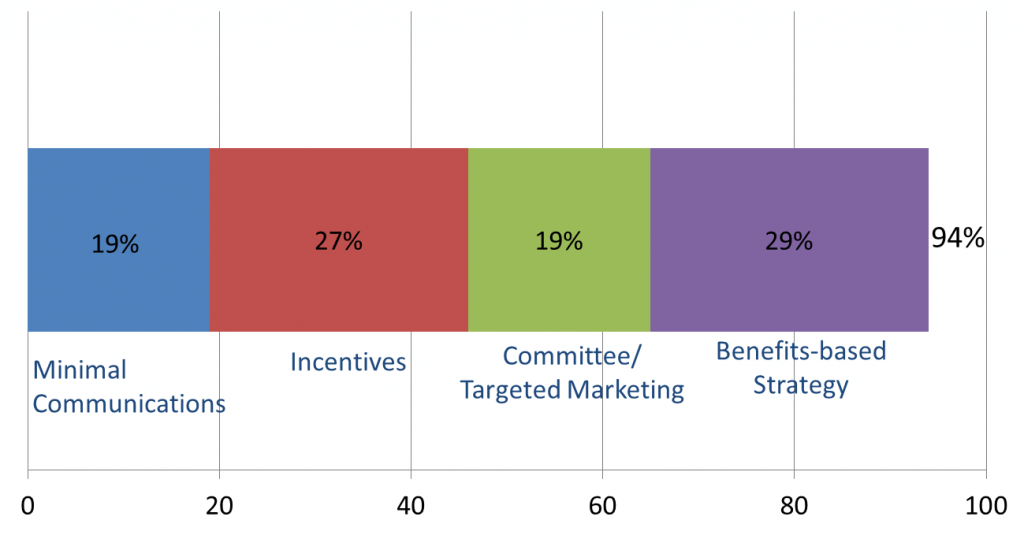
2011/2012 Staying@Work Survey Report; Towers Watson/National Business Group on Health and WellSteps Aggregate Data
When combined, a well-organized workplace well-being initiative should be able to reach at least 90% participation. This level of participation is a great start but it is not a complete wellness strategy.
How to Transition from Extrinsic Incentives to Intrinsic Motivators
Here is an example of a WellSteps campaign poster. The very first thing on the poster is a call to action to an intrinsic reward: “Feel Less Stressed Now.” The poster mentions the possibility of winning a $50 gift card but more importantly it talks about the intrinsic benefits of being able to control your stress.
The focus is on the intrinsic rewards not the incentives. The poster for the WellSteps Move It Campaign starts with, “You will feel and look better than ever.”

.
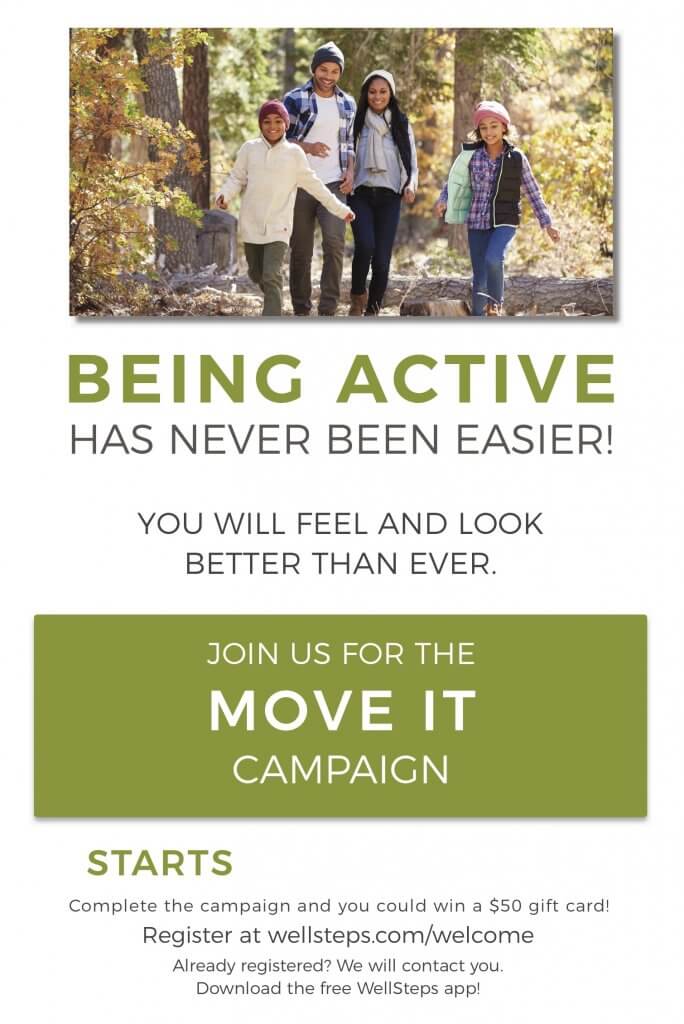
At the end of every WellSteps behavior change campaign, we ask participants how their life has improved. Doing this reminds them of all of the intrinsic benefits they can experience when behaviors are adopted and maintained for life.
For example, in the WellSteps campaign called Feel Fitness, employees are encouraged to participate in regular physical activity to help raise money for a good cause. They are also encouraged to pay attention to the benefits of exercise each week.
This way, while employees are helping others, they also discover benefits of regular exercise. Helping employees recognize and enjoy the benefits that come regular exercise will increase the odds that they will become a maintainer.
Helping employees experience the intrinsic rewards that come from healthy behaviors will help them enjoy healthy lifestyles for many years to come even without the wellness program.
Don’t make a big deal of the incentives.
Make a big deal out of the benefits.
Employee Wellness Programs Incentives: Carrots vs Sticks
Wellness professionals and companies often discuss whether or not to use incentives or disincentives within their incentive program. In other words, which is better to encourage behavior change, carrots (positive rewards) or sticks (punishments)? Remember, the goal of every corporate well-being program should be to help employees adopt and maintain healthy behaviors for life.
Some employers insist that the only way their employees will change behaviors is if they are punished for unhealthy behaviors. Punishing employees is the same technique cowboys use to train horses! To get a horse to do a target behavior, trainers make the right choice easy and the wrong choice painful.
Employers do the same thing when punishment is used to encourage non-smoking or having healthy blood cholesterol, etc. It is no surprise that the companies that punish employees are also most likely to have a toxic culture.
There are many logical arguments for and against the use of punishments as a way to change behavior. We live in a society where punishments for poor behaviors are common place. Break the law and you get punished. The belief is that a punishment will help people extinguish or stop poor behaviors.
There may be times when this approach is successful in a workplace setting. For example, some workplaces are extremely dangerous so safety is a number one priority throughout the organization. Everybody agrees that employees need to be safe at work so failure to follow safety protocols could lead to termination or punishment.
In some situations, negative reinforcement can impact behavior but this reinforcement is often accompanied by fear. Fear can be a motivator when it comes to adherence of safety rules, but it is not very effective in helping people adopt and maintain healthy behaviors.
WellSteps has worked with hundreds of clients and we discourage all of them from using negative reinforcement (sticks) to motivate employee health behavior.
We believe this approach is counterproductive to the goals of the wellness program. Also, there is no evidence to suggest that a wellness program which uses punishments will have any long-term success. Maintainers are mostly likely to develop lifelong healthy habits when they experience consistent positive reinforcement over a long period of time.

Simpler is Always Better
What would you say if you were hired to consult with company about an incentive program that had over 100 lines of activities, requirements, exceptions, rules, point totals and reward standards? Complicated much?
This is a real company. Someone within the company had invested a lot of time and effort into getting this wellness incentive program designed and tested. They had worked hard to create the program which used an elaborate Excel spreadsheet and point system.
When the program went live, they were surprised that no one participated despite the sizable incentive reward. The program might have been too complicated and cumbersome. The truth is that participating in that program would have been about as simple as completing a tax return!
For a well-being incentive program to be effective, it must be easy to explain, easy to understand, and easy for employees to use. Today, everybody has a smart phone and with the WellSteps app we have made it easy for our clients to validate their wellness activities with just a few clicks. When it’s easy to use and understand, employees will participate.
What should be included in an employee well-being program?
There are several components to a successful wellness program. Some ideas include:
- Behavior change campaigns
- Wellness activities to promote healthy habits
- Smoking cessation programs
- Health Coaching
- Exercise tracking (with device integration)
- Wellness incentives for employees
Feel free to click on the links above to learn more about each of these components of wellness. Let’s take a deeper look at incentives for wellness programs.
Wellness Program Incentives Are a Small Part of Wellness
It is hard for most people to change behaviors, but it is pretty clear what it takes for them to succeed. The AMSO model of behavior change drives everything we do at WellSteps. This model includes four main components. In order for employees to successfully adopt and maintain healthy behaviors, they need to become aware of and educated about their target behavior.
They need to be sufficiently motivated to change. They need the skills and tools required to be successful. They need support from others. Lastly, they need a supportive environment with rules and policies that make it easier to maintain the behavior for life. Wellness incentive programs are a tiny component of this larger strategy.
There are many ways to motivate employees to improve lifestyles including: using punishments with the corresponding fear, explaining intrinsic benefits of healthy behaviors, helping employees to experience the pleasures that come from healthy behaviors, and providing positive peer pressure.
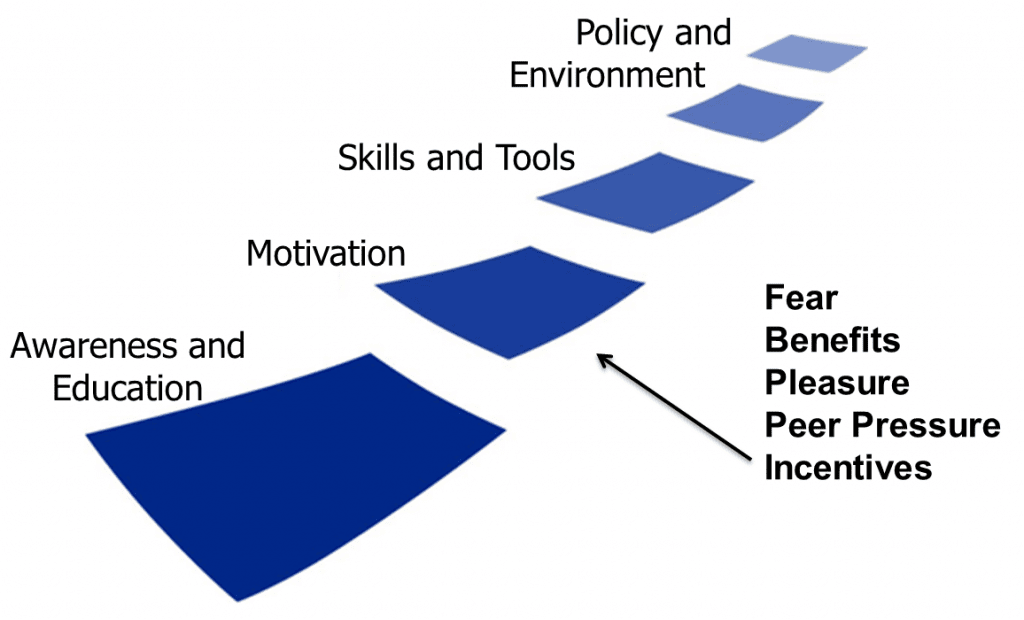
There are other ways to motivate employees as well. Employee recognition can go a long way to reinforce positive performance. Creating a poster for each of your wellness champions and letting them share their wellness story with others. Using before and after pictures or letting employees tell their story in their own words.
These stories can be shared in company newsletters, on company websites, or they can be posted in a special Hall of Fame somewhere in the building. Incentives are just one way to motivate employees to transform their lives. It is important to include other forms of motivation in an effective wellness incentive program.
Different Ways to Motive Employees

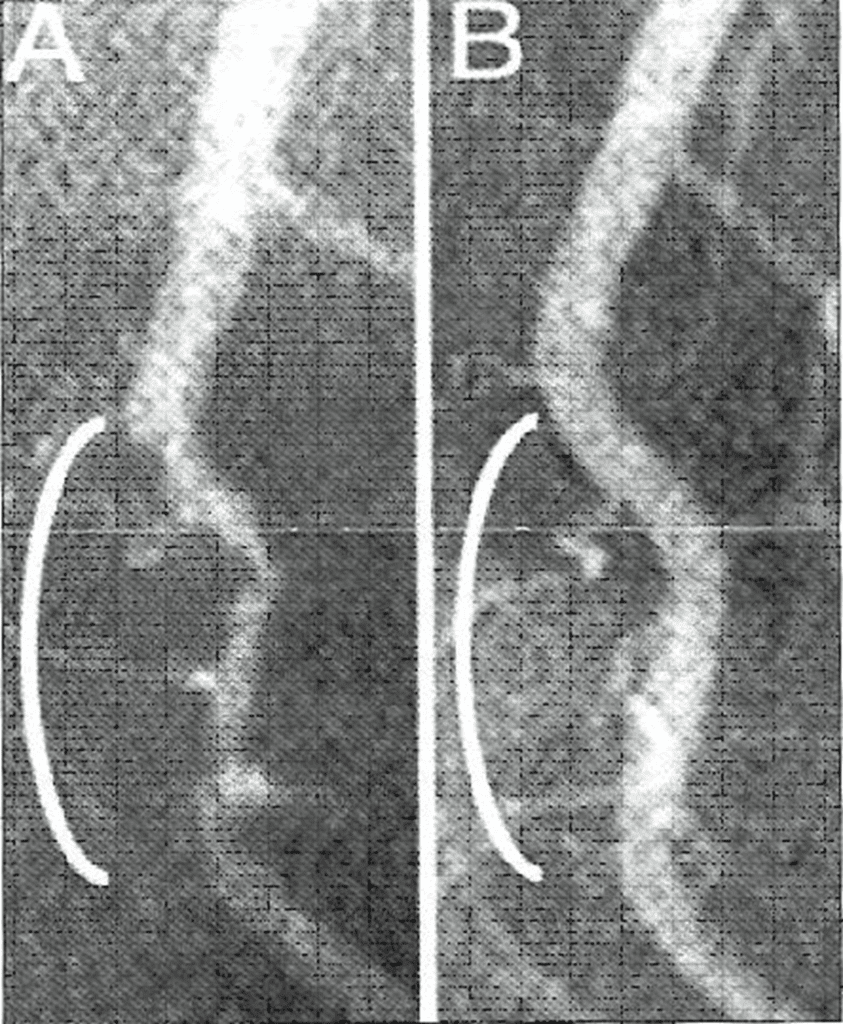
Many times wellness incentive programs become THE wellness program. The tracking, awarding, and processing of the incentives consumes the wellness budget and personnel time. Too many wellness programs are not really wellness programs at all. They are employee incentive programs.
This narrow focus on incentives means that much of the meat and potatoes of effective wellness has been completely abandoned. The AMSO model helps maintain the focus on the end goal: helping employees adopt and maintain healthy behaviors. Wellness incentives should be one part of all well-being programs, but nothing more than that.
Over the past 10 years, WellSteps has seen some excellent and some horrible wellness incentive programs. From our experience, here are the 5 most important practices:
Wellness Program Incentives Best Practices:
- Use incentives, but don’t make a big deal of them. Make a big deal out of the benefits.
- Make sure your employees know what all the benefits are. Give them a “What’s in it for me?” list.
- Never use punishments.
- Use both immediate incentives and larger benefits-based rewards
- Start with incentives – transition toward intrinsic rewards
WellSteps has had several clients that have made incentives simple but effective. Having very clear communication as to what the employee participant will earn at the end of the program year is important. An example that we have seen as a successful program incentive is 1 point = $1. This motivates participants because they know exactly what they are earning and what they will receive at the end of their program year. We have seen all sizes of companies use this incentive method. Company sizes have ranged from 50 employees to 28,000 employees. Although this is a great incentive, there are so many simple and effective wellness program incentives.
FAQs
What are good prizes for employee well-being programs?
The prizes for a wellness program largely depend on the budget of the company. Below are several wellness incentive examples for all budgets.
- Sports equipment (running shoes, wearable devices, etc.)
- Gift cards
- PTO
- T-Shirts or other company branded materials
- Water bottles
- Benefits (lower insurance premiums or deposits into HSA)







Thank you for this amazing blog, I have been trying to get my clients to do the same thing!